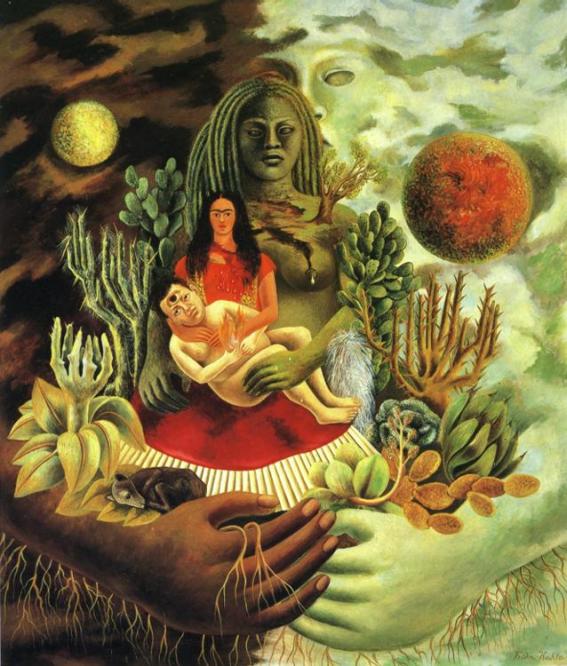I have a very love-hate relationship with modern art (1900 – present). Some pieces I really love, like Umberto Boccioni’s Unique Forms of Continuity in Space and then there are pieces I don’t care for or more precisely don’t understand, like pretty much all of Marcel Duchamp’s art. For more information on Duchamp, check out this website. One period of art that I sometimes have a hard time understanding is Surrealism. When most people think of surrealism, Salvador Dali usually comes to mind. While I think Dali as a person/creator was very interesting, I don’t particularly like most of his paintings. Frida Kahlo is another story. I find her life story to incredibly fascinating and a bit heartbreaking, and yet she created such fascinating work. Frida never considered her work to be Surrealist and didn’t include her work in a Surrealist until 1940. She, according to this webpage, “used surrealistic elements to paint her own reality; she considered these elements to be the most honest expression of herself.” This same website lists her work chronologically and found a couple pieces that I wanted to discuss. If you like Surrealist work, I would be interested to hear other people’s opinions on these works as well.
The first piece I would like to discuss is Memory (The Heart). According to www.fridakahlofans.com, where I found the painting, “In this self-portrait, she displays her anguish after learning that her younger sister Cristina was having an affair with her husband Diego Riviera.” In punishment for what her husband has done to her, she cut her hair really short (he loved her long hair) and adopted a more European/Western style of dress. On her right is a traditional native Mexican/Tehuana outfit, that Diego love to see her wear, but she now despises because of his betrayal. Her bleeding heart is on the ground. The hole where her heart was is impaled by steel rod and a cupid sits on either end. To her right is her school uniform, which according to the website’s author “reminds her of a happier time when she first met Diego.” This painting reminds me of a piece I did for a hand-building clay class during my undergraduate years. We had to create a vessel with a top. While I didn’t use a bleeding gaping heart as Frida did, I did use a brain with a giant screw coming out of it on top of a Pre-Columbian step pyramid. This piece was supposed to symbolize me getting screwed by my ex-boyfriend who broke my heart and cheated on me while I was studying art in Italy for my study abroad program.
Memory (The Heart), 1937
The second piece was done 12 years after the first one. Though this one is a lot more odd looking than the first one, I like it even better because of the Aztec mythology involved in the painting. In this piece, we see more of Frida’s maternal nature coming out. When she was 18, she was involved in a streetcar accident in which “a metal handrail penetrated her abdomen, leaving her temporarily paralyzed. She fractured her pelvis and the handrail also pierced her uterus.” In fact, she miscarried three times during her lifetime, a topic on which she painted many pictures. I found this article on the Huffington Post, which the preceeding quote was taken from, which discusses how new medical studies have determined what actually made her infertile. Because of her inability to conceive, she tended to mother Diego, even though he was 20 years her senior. This is exactly what she is doing in this painting, holding him like the Virgin and child paintings popular during the Renaissance. “The Aztec Earth Mother, Cituacoatl, holds both Frida and Diego in her lap, and she is hugged by the Universal Mother. The dog sleeping in the foreground represents Xolotl, who guards the underworld (taken from this website).” I especially like the photo of the artist with the painting on the bottom right of this page.
The Love Embrace of the Universe, the Earth (Mexico), Myself, Diego and Señor Xólotl, 1949
I
I discovered Jacek Yerka’s paintings a couple of weeks ago. He is a Polish Surrealist who started painting in 1980 and continues today. According to the biography on the artist’s website: “One need only glance at the luminous surfaces of Yerka’s canvases to perceive his adoration of, resonance with, the master painters of the 15th and 16th centuries; Hieronymus Bosch, Pieter Bruegel, Hugo van der Goes and Jan van Eyck were powerful, early influences.” Jan Van Eyck, a personal favorite of mine, was incredibly detailed and used realism (which was very modern for the Renaissance time frame in which he painted). Hieronymous Bosch painted surrealistic landscapes circa 1500, 400 years before the Surrealist movement happened in modern art, his most famous piece being The Garden of Earthly Delights. Here are some of the Jacek Yerka paintings that I have found so far that I liked, which can all be found on his online gallery:
Aquarium, 2007
Brontosaurus Civitas (couldn’t find date)
Creating the Water (couldn’t find the date)





You must be logged in to post a comment.